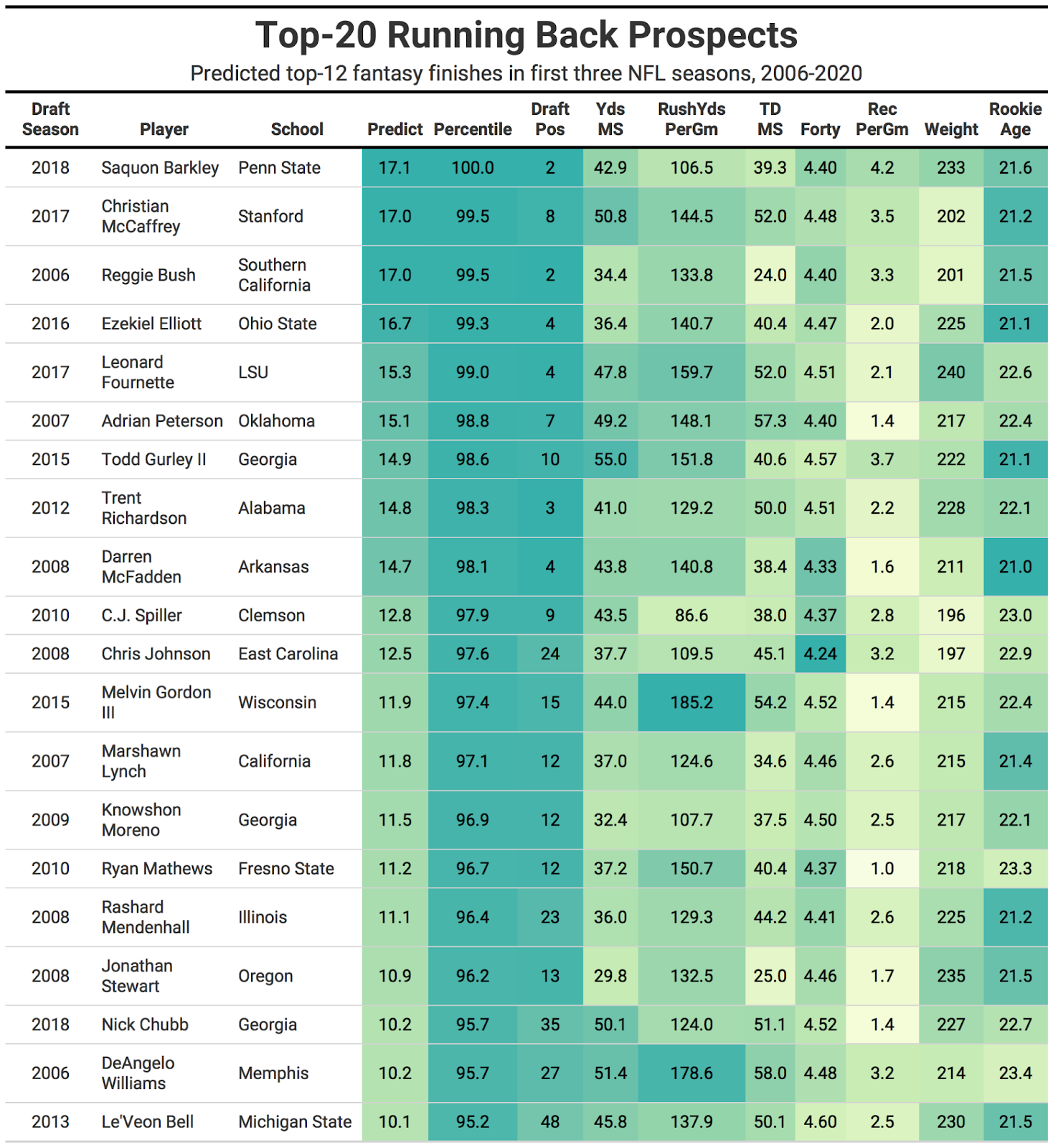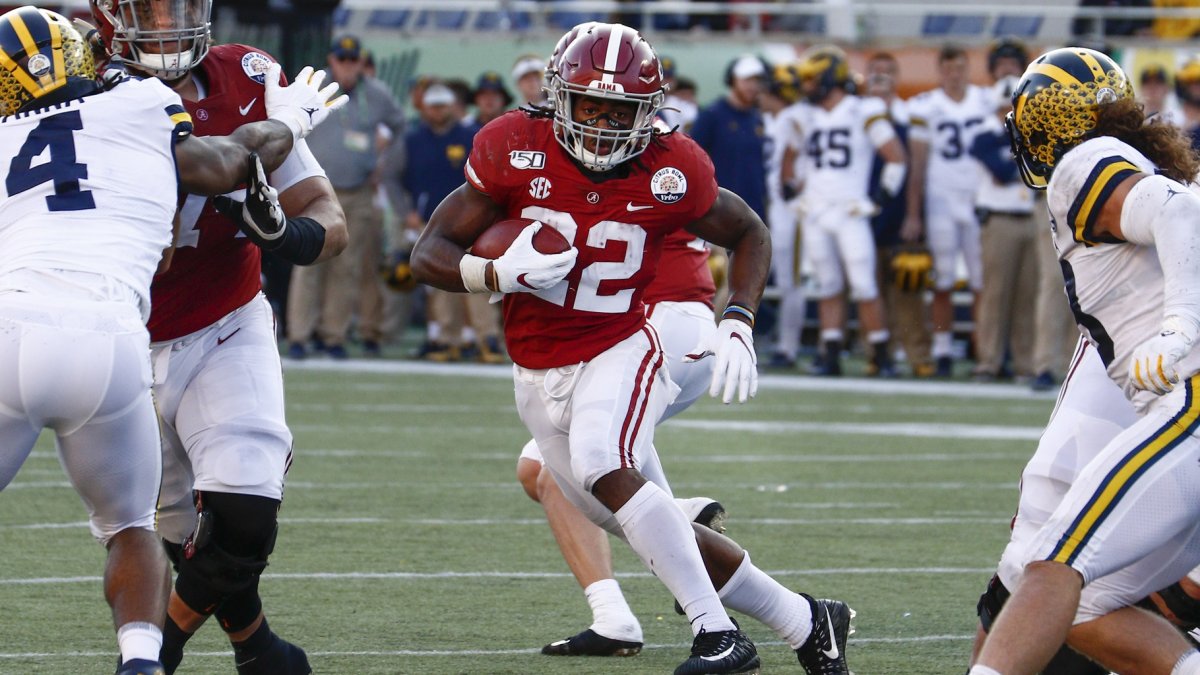Predictions can be hard, especially about the future. Even those who have dedicated their lives to draft analysis, such as the scouts in NFL front offices and outside draft prognosticators, are often wrong. All the best among them can do is tilt the odds in their favor and then hope over the course of several picks those favorable odds translate into better talent.
A big problem with most evaluations isn’t the expertise of the evaluator but the ability of those on the outside to parse how the final grade was determined. Most draft profiles include written analysis and reference traits seen on film and stats accumulated through college careers, but the process of how much weighting is given to each factor and how they all come together into a comprehensive, single number is, at best, somewhat opaque.
In this analysis of 2021 NFL Draft prospects at the running back position, I’m going to detail the quantitative process behind the results, including the importance of different features and how measurables, workout metrics and production markers all blend into a single prediction. In this case, the prediction will be focused on fantasy football results, specifically the number of top-12 weekly finishes at the position over the prospect's first three NFL seasons. We could extend the window further to cover a player’s entire career, but the point in the real NFL draft and the fantasy rookie counterparts is to see a return on investment earlier rather than later.
This analysis will cover all the 2021 running back prospects on the PFF Top-300 Big Board, using their Pro Day number and production metrics to forecast fantasy success.
View PFF's 2021 NFL Draft position rankings:
QB | RB | WR | TE | T | iOL | DI | EDGE | LB | CB | S
METHODOLOGY
This analysis uses what is known as an ensemble model, or a blend of the results from different models that are then blended together to form a single and hopefully more precise final prediction. One of the models is tree-based, the other linear. The historical data from previous running back classes going back to 2006 and through 2018 were used to train the models, including the number of actual top-12 weekly fantasy finishes for those previously drafted running backs. The historical fantasy finishes are based on points-per-reception (PPR) scoring.
The features for each running back in the models are as follows, ordered by relative importance and statistical significance. The stats are from the prospects’ best statistical season in which they played at least five games and logged at least 100 carries:
- Draft position
- Share of total team yards
- Rushing yards per game
- Share of total team touchdowns
- 40-yard dash
- Receptions per game
- Weight
- Age
Draft position is, by far, the most important feature in predicting fantasy success for running backs, followed by production and then measurables. Workout metrics in the model were limited to the 40-yard dash due to its ubiquity and outsized influence on NFL draft position for running backs. For the 2021 class, the 40-yard dash times are from Pro Days, with a 0.03 penalty for comparison to combine times.
I am using the expected draft positions from the top-150 list at GrindingTheMocks.com as a proxy for actual draft positions for the yet-to-be-selected 2021 class. For prospects unranked according to recent mocks, I’m adding 10 draft slots to the last ranked running back by the order of our big board.
Higher drafted running backs at top programs are more often coming from backfields with two or even three drafted players, thereby diluting their shares of team production having to split workloads. To account for this, I adjusted up the shares of total team yards and touchdowns for running backs who played with other drafted running backs in their final seasons.
HISTORICAL RESULTS
Below are the top 20 running backs drafted from 2006-20 by predicted top-12 fantasy finishes. Keep in mind that the data from 2006-18 was used to train the very model doing the predictions here, so overfitting can bias the results toward those running backs who ended up being most successful.

The table highlights the strong relationship between draft position and forecasted fantasy finishes. The top 20 backs were all first-round selections, save for Nick Chubb and Le’Veon Bell, and Chris Johnson is the only player with top-10 projected fantasy finishes who wasn’t also a top-10 pick in the NFL draft. The relationship between draft position and fantasy forecast is materially higher for running backs than wide receivers — draft capital can dictate usage, and fantasy scoring at running back is heavily influenced by volume.
Exclusive content for premium subscribers

WANT TO KEEP READING?
Dominate Fantasy Football & Betting with AI-Powered Data & Tools Trusted By All 32 Teams
Already have a subscription? Log in




 © 2025 PFF - all rights reserved.
© 2025 PFF - all rights reserved.